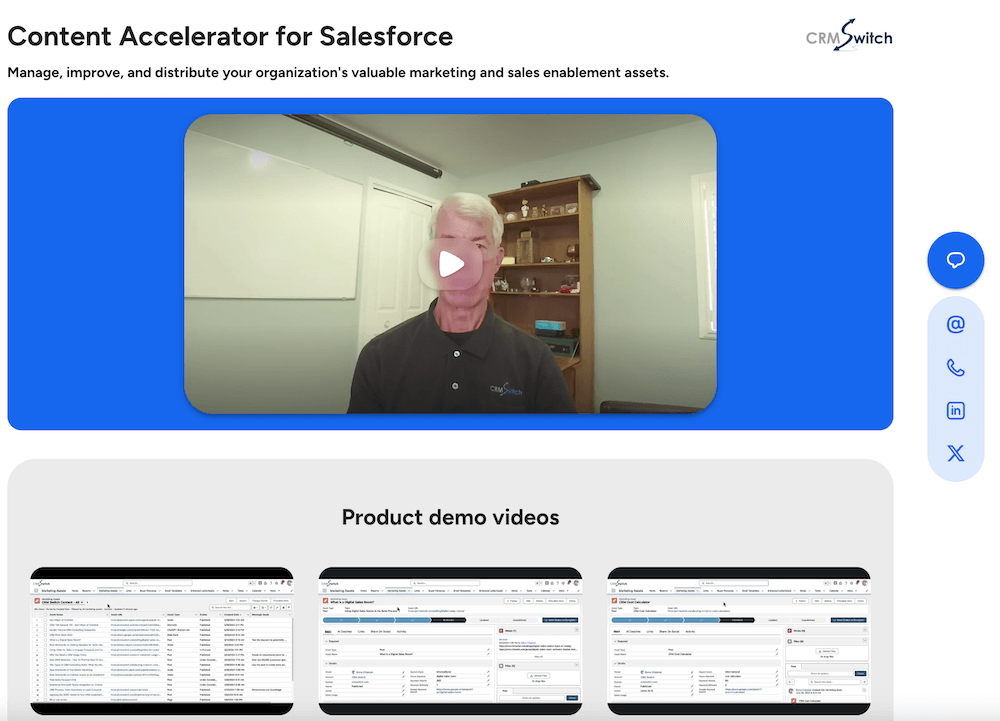A Digital Sales Room (DSR) is a microsite where a salesperson can share timely and relevant digital assets — personalized videos, presentations, and product brochures — with specific prospects and customers.

For some vendors, DSR is the core offering; for others, it’s a subset of a broader sales enablement offering.
Certain DSR vendors, like OneMob and Vidyard, are video-for-sales hosting platforms.
Others, like Aligned, rely on embedding videos from other platforms, like Vimeo and Vidyard.
Gartner expects that by 2025, 80% of B2B sales interactions between vendors and buyers will occur in digital channels.
Implementing sales room software can produce an ROI for many organizations, but adoption can be challenging for others.
How Digital Sales Rooms Work
Online sales rooms help salespeople acquire more new customers faster and allow account managers to manage existing customer relationships better.
The platform category facilitates asynchronous communication, enabling sellers to provide tailored information that customers and prospects can consume at their convenience.
A salesperson without web design skills but with proper onboarding and training can create a landing page with personalized videos, general marketing videos, slide decks, PDFs, documents, calendar embeds, and more.

According to Wyzowl, 91% of businesses use video as a marketing tool. Sales reps can blend video content they record with marketing-supplied video content.
Marketing videos and other marketing assets can be added below the fold in the above example.
A Digital Sales Room can include buttons that allow prospects or customers to call, email, or text their sales representative quickly.
By consolidating vendor-to-prospect and vendor-to-customer communication on one page, a DSR reduces back-and-forth fragmented email communication.
Communication Use Cases
There are three communication use cases for DSRs:
- 1:1 – a user creates a microsite to share with just one person
- 1:Many – a user creates a sales room to share with a team of people at an account
- Many:Many – a microsite is created so that any user can share it with anyone else.
A Many:Many microsite may be created by the marketing department for sales users to distribute.
CRM Integration
DSRs can be integrated with CRM systems like Salesforce, Microsoft Dynamics, and HubSpot. A significant integration benefit is that DSR can show the technology’s attribution impact on opportunities.
For example, with a multi-touch revenue attribution model, a DSR might get 50% attribution credit for a deal closing.
Another integration feature — emails sent from the sales room can be recorded to Leads and Contacts in CRM so that a CRM user can track past communication with a prospect or customer through this medium.
A custom table in a CRM database can be used to manage and share Many:Many sales rooms using CRM email templates.
Implementing Digital Sales Rooms: Strategies for Success
Revenue leaders and other stakeholders often consider the implementation of DSRs across their entire sales and account management teams.
As with many sales tools, a DSR platform is only an enabling technology.
The initiative needs ongoing top-down support, internal ‘evidence of effectiveness,’ and consistent attention to produce positive results.
Identify Your Objectives: Clearly define what you aim to achieve with DSRs, such as improving close rates, reducing sales cycles, and increasing customer retention.
Choose the Right Platform: Select a DSR platform that aligns with your sales process, integrates with your existing CRM and sales tools, and offers the necessary features and analytics.
Train Your Team: Ensure your sales team is appropriately onboarded and trained to use the DSR platform effectively. This includes understanding how to record videos, integrate slide decks, upload brochures, and leverage analytics to discover what’s working best.
Leverage an Internal Proponent: No matter how much vendors and management promise DSR’s effectiveness, there’s no substitute for a peer declaring how well DSR usage has worked for them.
Present Options to Users: If specific users are uncomfortable putting themselves on camera, they can create off-camera communications such as narrated slide decks and software screencasts.
Monitor and Optimize: Continuously monitor the performance of your DSRs and gather feedback from both sales teams and customers. Use this data to optimize your DSR strategy and improve outcomes.
For revenue leaders looking to keep pace in the digital age, Digital Sales Rooms can offer a powerful solution to drive revenue growth.
By leveraging DSRs, organizations can provide a personalized and engaging buyer experience backed by data-driven insights. These insights enable sales teams to close more deals faster and enhance relationships with existing customers.
Implementing a DSR platform requires careful planning and execution, but the potential benefits for sales organizations are substantial.
As the digital landscape evolves, adopting innovative virtual sales tools like DSRs will be crucial for maintaining competitive advantage and achieving long-term success.


